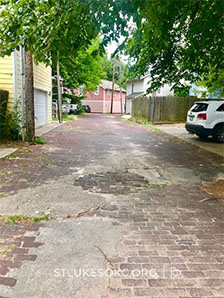“Therefore let us stop passing judgment on one another. Instead, make up your mind not to put any stumbling block or obstacle in the way of a brother or sister.” – Romans 14:13
I like to walk in the neighborhood—for both daily exercise and for a chance to see the neighbors and friends that I don’t get to visit with as much anymore. I also find myself inspired when I see someone planting flowers, repainting their house, or embarking on any number of home improvement projects. The path I take varies as I work to achieve my walking goal—but I am always intent on observing and seeing as many parts of my neighborhood as possible. One day I saw my friend, Karen, coming out of the alleyway, walking her dog. A few days later, I saw her in my alley, again happily walking her dog and enjoying her walk. This time she stopped, and we talked for a moment, then she asked, “Do you ever walk in the alleyways in our neighborhood? You see some of the most interesting parts of the neighborhood from the other side.” I paused and realized that I’d never even thought about that or considered that walking in the alleyways was an option. Sure, I drive into the alley to access my driveway, garage, and quietly slip into my house. Once a week, I go out there and push my trash can to the curb, but I can’t imagine enjoying my daily walk with the intent to spend the time in the alleyways of the neighborhood. In fact, most of my life, I had been warned away from the alleys. If my travels took me to large metropolitan cities—avoiding the big city alleyways was paramount. Loose dogs, wanton activities and financial deals gone wrong—all of them happen in the back alleys of the world.
Karen’s enthusiasm to “seeing the other side” had piqued my curiosity, however, and the very next day I decided to check out these less-traveled roads. The first street I took seemed uneventful; the path was unpaved, the area a bit overgrown with weeds and there were the usual trash cans, and solemnly shuttered doors and windows. I was relieved to not see any reckless or unfavorable activities; no deals being made and not a single ruffian or loose dog. I trudged on determined to see the attraction of the alley path. The next street seemed more promising as I headed done the alley. Someone had equipped a half court basketball area complete with a makeshift scoreboard and spectator bench. Then I spied a beautiful garden, well-tended and full of vegetables ready for harvest. Then I saw the most well-kept fence line with hanging vines of trumpet plants and ivy—all looking as loved and cared for as the many front yards I usually see. The next street brought even more surprises—a partially paved brick street and remnants of the homes built in the early 1900s with original facades giving a glimpse of what it might have looked like then. I found that many people had rebuilt new garages and entries in front, but they had used the old space in back to create pergolas and decks, sitting areas and secret gardens. As I headed down another, I was met by a rabbit who was surely a pet because he did not bound away, instead he ignored me and continued to nibble grass like I had interrupted his daily routine. Sure, there were a lot of long forgotten tools, and toys from children who had grown up and since moved on, dilapidated sheds and a few slow running cars, but even these brought sweet memories of a different time and there were many hidden gems I would have never even knew existed if I hadn’t taken the time to travel a different path. Most of all, I was moved by the ways so many people took time to care for and enhance an area that so few would see, except for their neighbors who also entered the alleyways to access their garage.
As I think about these new roads I have traveled, I consider how easy it is to judge people from their front yard—is the grass mowed, does the paint look chipped, are the plants blooming and tidy, is there trash or junk in the front yard. But in the alleyway, there are no judgements—you don’t have to be perfect, you can have the old trash cans, items waiting to be repurposed or tossed, the weeds can grow a little longer, the fence can need repair. We all have an area that we neglect because no one will really see—so it is easy to be forgiving of others as well.
So often we only see and appreciate beauty in the obvious areas that surround us, and we don’t have much patience in seeking out things we are unfamiliar or uncomfortable with. I am thankful for my friend who encouraged me to see and appreciate the “other side of the street.” I am also thankful for my neighbors who care enough to take care of the hidden areas, not because everyone will see and admire their beauty, but because someone just might happen upon it and get to share in the humility of these little secret spaces.
My prayer is that we give our neighbors as much grace for their front yard as we give them for their alleyways.
– Lori Hall, Executive Director of Missions



